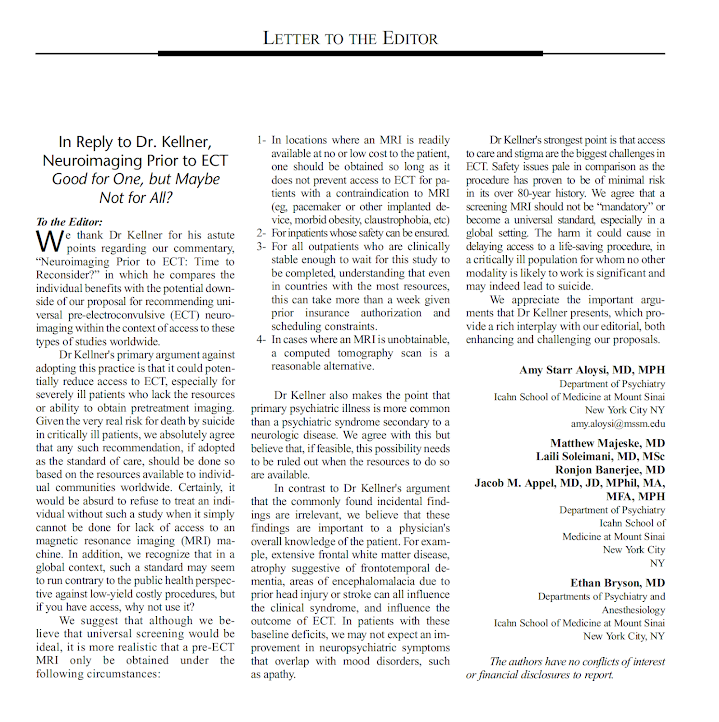Neuroimaging Prior to ECT: Part Three, Dr. Aloysi and Colleagues Respond to Kellner
Out on PubMed, in JECT, is this response:
In Reply to Dr. Kellner, Neuroimaging Prior to ECT: Good for One, but Maybe Not for All?
J ECT. 2023 Apr 14. doi: 10.1097/YCT.0000000000000923. Online ahead of print.PMID: 37053439
The response is here.
And here.
I would very much like to hear opinions from blog readers, thanks.




The below comment is from Dr. W. Vaughn McCall:
ReplyDeleteI read with interest the debate between Dr. Kellner and Aloysi and et al. regarding the merits of whether or not a brain image (MRI or CT were suggested) prior to the initiation of ECT is warranted. The debate centers chiefly around the merit of the discovery of an incidental finding prior to ECT that would be actionable and change the treatment plan, versus the downside of the cost and hassle of the imaging, and perhaps stigmatization of ECT as a dangerous treatment.
I am reminding of the circumstances of my training in ECT in the mid-1980s. At that time, we routinely ordered thoracolumbar spine films (in order to be aware or preexisting spinal fractures) and an electroencephalogram (EEG). The EEG was ostensibly in order to detect focal slowing suggesting a brain tumor, although there was also interest in any incidental epileptiform activity and/or generalized slowing.
The routine ordering of spine films and EEGs was discarded by the mid-1990s in all the ECT practices of which I am aware. They were discarded as low yield and an extraneous cost. Of course, there is also the problem of unnecessary radiation exposure with the spine films.
I think this history has some relevance here, but the reader can decide for themselves.
If we were to expand our routine diagnostics before ECT, what might they be, if not brain imaging? I would suggest there are other tests which are cheaper, probably more illuminating, and free of radiation. These would be (1) a urine drug screen to detect occult drug use prior to ECT, (2) a Mood Disorders Questionnaire (it take 5 minutes and is free) to detect otherwise unsuspected bipolar disorder, (3) PCL-5 ( a self-administered checklist for PTSD) to detect otherwise unsuspected PTSD, and perhaps a screening tool for Borderline Personality Disorder.
My reasoning is that substance abuse, bipolar disorder, PTSD, or Borderline Personality Disorder are relatively common, and could shape the outcome of ECT for a presumed diagnosis of Major Depression.
I look forward to comments and criticisms from colleagues.
Vaughn McCall